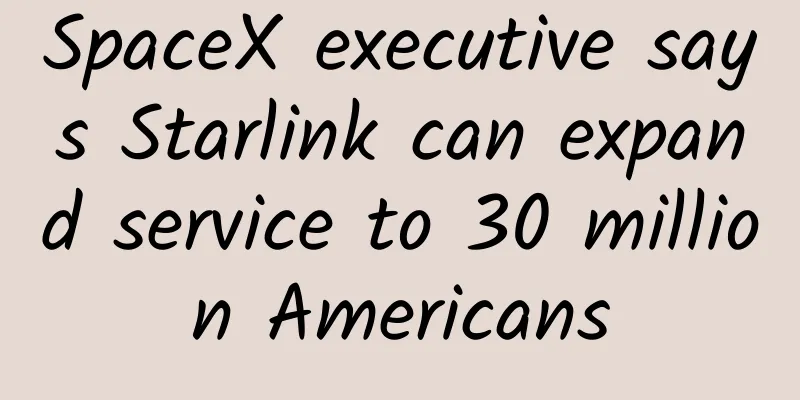SpaceX executive says Starlink can expand service to 30 million Americans

|
SpaceX's satellite internet service, Starlink, will not completely rule out providing coverage in urban areas, though it aims to optimize service in rural and underserved areas, according to a report filed earlier this month by David Goldman, SpaceX's director of satellite policy, with the Federal Communications Commission.
In the latest presentation, SpaceX executives outlined to the committee how the internet service could scale up operations to provide data connectivity to 30 million Americans who currently have no internet coverage or no service. He also criticized research on satellite communications by companies such as RS Access, saying it made overly restrictive assumptions about satellite internet, used "pirate" information and used data that did not represent real-world performance. Starlink claims that MVDDS licensees are "spectrum hoarders" who do not provide useful consumer services. Goldman's comments came in the form of a presentation made during a meeting with commission officials earlier this month, in which the SpaceX executive took aim at a study submitted by RS Access and conducted by RKF Engineering Solutions that was intended to demonstrate that multi-channel video data distribution (MVDDS) service providers and non-geostationary fixed satellite service (NGSO FSS) providers could use the 12 GHz band without significantly impacting each other's services. The study was designed to refute a study submitted by DISH several years ago that claimed satellite companies could not coexist with other companies in the 12 GHz band. However, Goldman believes that it is flawed in several ways because it relies on spoofed data, false rural and urban divisions, inaccurate assumptions, and ultimately depicts significant interference from MVDDS providers to satellite internet users. In response to the RS Access study, SpaceX's Goldman said the report severely underestimated future demand for satellite internet. One assumption used in the RKF study is that even if Starlink employs 2.5 million user terminals, interference from MVDDS 5G providers will be minimal because the satellite terminals will serve rural areas and the 5G terminals will be in urban areas. In a detailed rebuttal to the study, SpaceX’s Goldman refuted this assumption, saying: Of the 2.5 million user terminals modeled (a lower estimate that is not entirely accurate), only 14,600 are placed in “metropolitan” RDAF areas, with the rest being in “non-metropolitan” and rural areas, where the study and RS Access, DISH, and other MVDDS licensees have acknowledged they never intend to deploy these terminals. That is, the study assumes that 99.4% of NGSO FSS user terminals will be deployed in such rural areas. This simply does not reflect reality. While SpaceX’s Starlink system will bring service to millions of Americans who are currently unserved or underserved by existing broadband, including in rural areas that MVDDS licensees clearly have no intention of serving, this is itself a dubious proposition given their history: SpaceX is authorized to provide and is providing competing broadband services to the entire United States, which would certainly overlap with any theoretical ground buildout. In fact, a large portion of SpaceX’s existing Starlink orders are already in urban areas. RKF Research Report on the rationale for allocating Starlink user terminals. Row 3 shows Starlink terminals in areas where SpaceX did not win funding but still deployed services. In addition, Goldman also stated in his speech that Starlink can scale up services to provide internet connectivity to unserved and underserved Americans. According to him, there are approximately 30 million people in the United States who lack adequate internet coverage, and "Starlink's architecture can be expanded to support unserved and underserved populations in the United States, including rural, suburban and urban areas." He also attacked an economic study submitted by the Brattle Group along with RKF's technical study, which claimed that opening up the 12GHz band for 5G use could provide economic benefits worth $1 trillion. Starlink is currently preparing to launch the second batch of its first phase of Starlink satellites, which consists of approximately 4,400 spacecraft, most of which are located at lower inclinations. |
<<: Analysis on the current status of global 5G development
>>: How edge computing, edge networking, and edge data management work together
Recommend
The arrival of 5G is getting closer and closer. "Wi-Fi will die" is not an exaggeration
Recently, the foreign research organization OpenS...
Secada releases the latest 2017 global Chinese PC antivirus software detection and killing capability evaluation report
Recently, the internationally renowned third-part...
China's commercial Wi-Fi market size exceeds 4.1 billion yuan, analysis of the three major development trends of the industry
Commercial Wi-Fi is a wireless Internet service p...
[11.11] Maxthon Hosting: 25% off on all VPS, top up 111 yuan and get 111 yuan free, US CN2/Hong Kong CN2/Germany CN2/Netherlands CN2/Hong Kong High Defense, etc.
Maxthon Hosting has released this year's Doub...
Network acceleration, who will revolutionize the future?
The Sanskrit "Sangha Vinaya" records th...
RAKsmart: Bare metal cloud server flash sale from $49/month, 125~253IP bare metal cloud cluster server from $130/month
RAKsmart offers a series of promotional products ...
To promote industrial upgrading, Ascend Academy Technology Open Day came to Shenzhen
On August 11, 2020, the DevRun Developer Salon As...
7 IT reorganization mistakes to avoid
The way IT operates is changing constantly and ra...
Delisted from the New York Stock Exchange! The three major operators gave a "cold" treatment, and the Ministry of Commerce and the China Securities Regulatory Commission responded with a "response"
Affected by the New York Stock Exchange's dec...
Why do mobile network testers still pursue speed at all costs?
Communications operators must refocus on covering...
Maxthon Hosting: Los Angeles data center connected to AS9929 line, 20% discount, monthly payment starting from 38 yuan
Aoyou Host is a long-established foreign VPS host...
Tencent Cloud Lightweight Cloud Server Existing Users Free Upgrade, No Price Increase for Additional Usage
Tencent Cloud, a major domestic cloud server manu...
The time is approaching! my country will have 5G commercial networks as early as the second half of 2018
The 5G standards will gradually be released next ...
What is FlexE in 5G bearer network?
[[413331]] This article is reprinted from the WeC...









